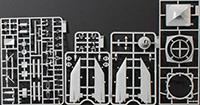
Takom 1/35 V-2 WWII German Single-Stage Ballistic Missile Kit First Look
By Michael Benolkin
| Date of First Look | February 2017 | Manufacturer | Takom |
|---|---|---|---|
| Subject | V-2 WWII German Single-Stage Ballistic Missile | Scale | 1/35 |
| Kit Number | 2075 | Primary Media | Styrene |
| Pros | Simple build | Cons | See text |
| Skill Level | Basic | MSRP (USD) | $24.99 |
First Look
 |
 |
Doctor Werner von Braun was a pioneer in early rocketry in the 1930s where he developed liquid-fueled rocket motors under the supervision of his mentor, Hermann Oberth. When the Nazi party gained power in Germany, von Braun was given research grants to develop the technology into what would become the Vergeltungswaffe 2 (reprisal weapon 2) or V-2.
The V-2 underwent numerous tests at Peenemunde to improve the reliability of the motor as well as work out the bugs in its structural integrity and guidance system. Like the modern AIM-9X Sidewinder of today, the V-2 used steering vanes in the rocket exhaust to vector the thrust to adjust the trajectory of the missile. This weapon would become the world's first ballistic missile with over 3,000 fired at allied targets (many of which were aimed at London).
After the war, von Braun and numerous other rocket scientists were brought back to the United States to continue their work in both military and scientific applications of their rocket technology. Over 300 rail cars of V-2 parts were also recovered and shipped to the US for further study and testing. Numerous test flights were conducted at White Sands Missile Range in New Mexico where the designs were evaluated and further developments began America's steps into rocket flight. While Robert Goddard was the first to fly a liquid-fueled rocket in 1926, it would be von Braun and his colleagues to put the concept to work and take that concept all the way to the moon as part of NASA's science team.
Takom released an interesting kit with the missile, transporter, and launch stool, then followed up with this kit of the missile and launch stool sans transporter. Aside from some extra parts that were left over from the first release, this kit is essentially the same as the DML kit first released over 20 years ago. Since my DML V-2 is one of the few kits that has survived the years, I thought it might be fun to build the Takom kit and compare the two.
The kit is molded in light grey styrene and presented on six parts trees. The surface detailing is finely scribed with no hint of flash and minimal mold lines. The plastic is softer than the DML plastic so extra care will be required when removing parts from the sprue trees and during assembly. I also found that Tamiya Extra Thin Cement may be too 'hot' for this type of plastic. While I've already assembled the airframe using Tamiya's cement, I might suggest using Testors Liquid Cement, but in any case, take your time. The fit of most parts is well done though the four fins took some work to get them to stay in place while the glue dried. I'll show the built-up model along with my old DML V-2 coming soon.
This is a simple build and if you heed the points above, you won't have any problems with this model. In fact, you'll spend more time painting than assembling this kit.







